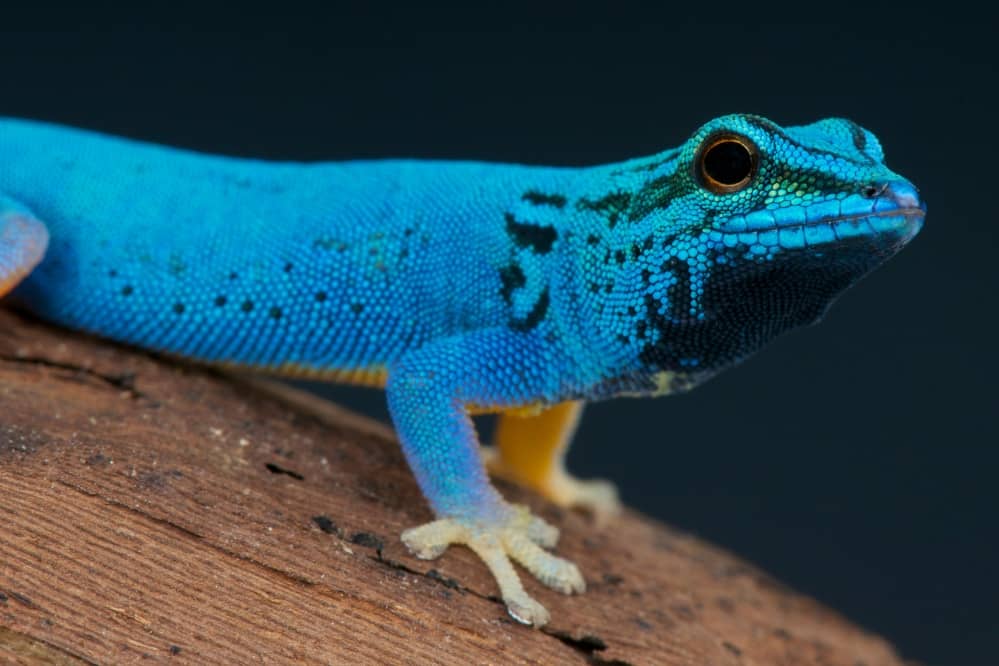Electric Blue Geckos are scientifically termed Lygodactylus williamsi; however, among the reptile fancier, they are also calledTurquoise dwarf geckos and William’s dwarf geckos. The electric blue geckos are relatively new but increasingly popular pets among reptile fanciers. Most reptile lovers are attracted to electric blue geckos because of their small size, striking appearance (vibrant blue coloration) and friendly demeanor. Despite a sudden increase in their demand, electric blue geckos are rare in pet trade and are not easy to find. This is so because electric blue geckos are found only on a particular type of palm tree (Pandanus palm) in the limited area of tropical forest of Tanzania. The loss of already limited habitat due to rapid deforestation has endangered these beautiful reptiles. Therefore, capturing blue geckos from the wild is prohibited, so captive breeding is the only legitimate way to obtain them.
Since Electric Blue Geckos are relatively new and rare simultaneously, there is not much information available about them, and “how long do electric blue geckos live” is the question most commonly asked by reptile enthusiasts. So this post is focused not only on answering the said question but also on how you can help your electric blue gecko to live long and happily.
How Long Do Electric Blue Geckos Live (Life Span Of Electric Blue Geckos)
Usually, the Electric Blue Geckos live for 8-10 years. The life span of these lizards depends on many factors like genetics, diets, environmental conditions, etc. Since electric blues are small (usually don’t grow more than 3.5 inches in length), they are relatively easy to maintain. So by providing a proper diet, a suitable habitat, and regular veterinary care, you can help ensure your electric blue gecko lives long and healthy. Generally, in captivity, electric blue geckos are known to live for 15 years.
How You Can Help Your Electric Blue Gecko Live A Long & Healthy Life
As mentioned above, electric blue geckos in captivity live 7-8 years more than those living in the wild. However, remember that providing a place to live is not enough. You must provide them with a habitat that mimics their wild environment. The useful tips below will help you make your reptile feel comfortable and enjoy healthy and happy years to come.
Provide Suitable Enclosure
Though electric blue geckos are small in size, they are highly active and arboreal reptiles, so they require a lot of space to climb and run around. Fortunately, it’s very easy to provide them with sufficient space they need due to their small size. An electric blue gecko can happily thrive in a 12″ x 12″ x 18” enclosure. This is the minimum requirement; your blue friend will not mind if you provide a bit larger tank. In addition, if you want to keep two electric blue geckos together for breeding, you need to arrange a larger tank measuring 18’’ x 18” x 24’’ or more.
Temperature Or Heating Needs Of Electric blue geckos
Maintaining proper temperature is the most crucial and tricky part of owning an electric blue gecko because these reptiles need varied temperatures during different situations. The temperature requirements of electric blues during different situations are given below.
| Temperature Required (°F) | |
| Basking spot | 90 – 95 |
| Upper enclosure ambient | 80 -85 |
| Lower enclosure ambient | 75 – 80 |
| Summer or Spring night | 65 – 75 |
| Winter or Fall night | 50 – 70 |
To maintain and monitor temperature continuously, installing a good quality thermostat and digital thermometer inside the enclosure is recommended.
Humidity Requirements Of Electric Blue Geckos
Electric blue geckos need an environment with higher humidity to be healthy and happy. So make sure to maintain 60-70% humidity inside the enclosure. Install a good quality hygrometer to monitor humidity and regularly mist enclosure to maintain humidity within the required range.
Lighting Requirements Of Electric Blue Geckos
It is a well-established fact that all reptiles need UVA and UVB lights to enhance calcium absorption and maintain their health, electric blue geckos are no exception either. In addition, these reptiles are diurnal, so make sure to buy good quality UVB lights and keep them on for 12 hours daily to mimic natural day-night cycle. It’s ok to follow this schedule throughout the year; however, in winter you can shift to 10-hour lighting.
Substrate Requirements Of Electric Blue Geckos
A substrate is a material that we use for covering the floor of the enclosure. It also helps to give captive environment a more natural look. For electric blue gecko, substrate should resemble tropical soil (which is slightly grainy and retain some moisture). So using a good quality substrate is crucial to ensure your pet’s health. The substrate should be at least 2-3 inches thick and should be replaced after 3-4 months. The poop, urates and contaminated substrate should be removed daily.
Environmental Enrichment
Enriching captive environment and providing necessary accessories are vital to keeping your tiny blue lizards in optimum health. It is necessary to keep him entertained and provide necessary physical activity. Lack of enrichment usually results in a bored, stressed inactive and dull pet. The enrichment item should be according to the natural needs of your blue reptile. Some common enrichment items are perches (to provide climbing opportunities), hides, and plants (natural and artificial).
Diet
As far as their feeding requirements are concerned, electric blue geckos are omnivores by nature, and they eat a variety of plants (fruits and vegetables) and insects in the wild. So it’s always better to follow their natural diet in captivity. Generally, in captivity, insects like fruit flies, hornworms, small crickets, small silkworms, small mealworms, reptiworms, and waxworms are fed to the electric blues. Since your blue reptile is very small, the insect you feed them should not be larger than 1/4th of an inch. Generally, baby and juvenile electric blues are fed worms daily, while adults are fed 2-3 times weekly. Similarly, baby and juvenile electric blues should have continuous access to fruits, while adults should only be fed twice a week.
In their natural habitat, these blue reptiles eat a variety of insects. In contrast, only a limited type of insects are available in captivity, so electric blue geckos regularly need calcium, vitamin D and multivitamin supplementation. Generally, experts recommend sprinkling calcium powder (including vitamin D) on every meal, while multivitamins should be given twice weekly.
Final Lines
We hope the above text provides enough information about the electric blue gecko’s lifespan and how you can improve your blue friend’s lifestyle and help him live some extra years.

